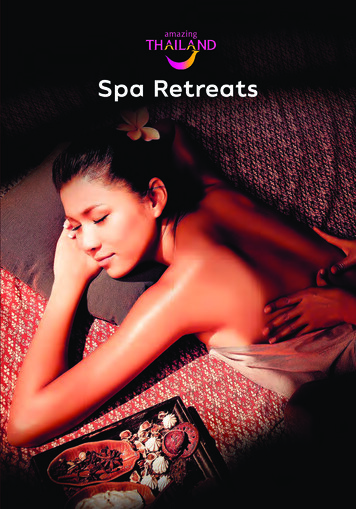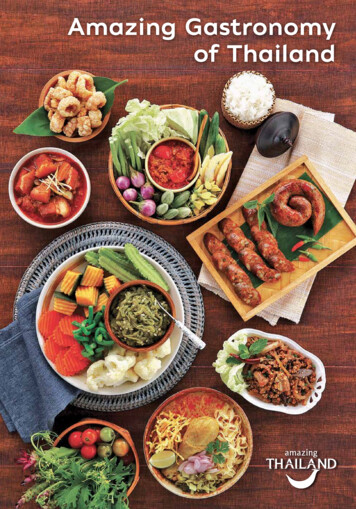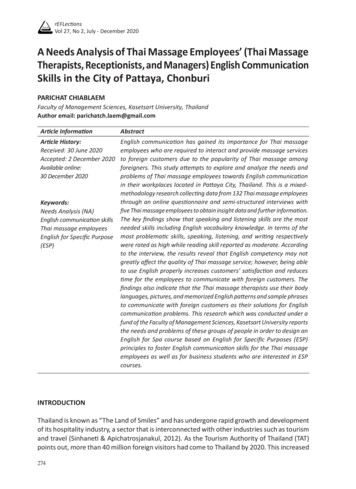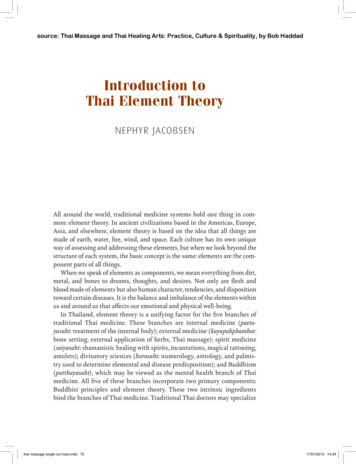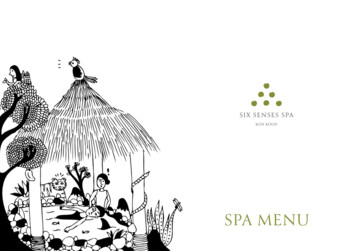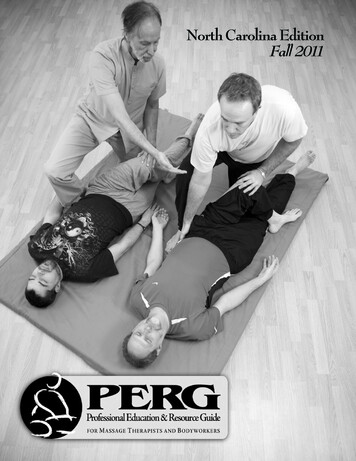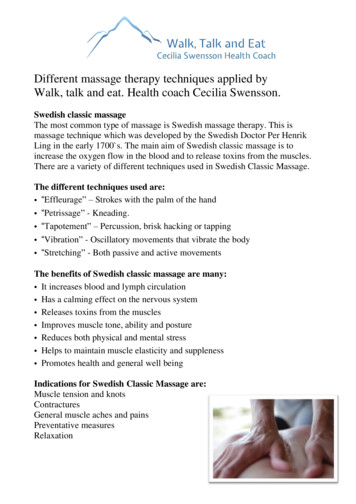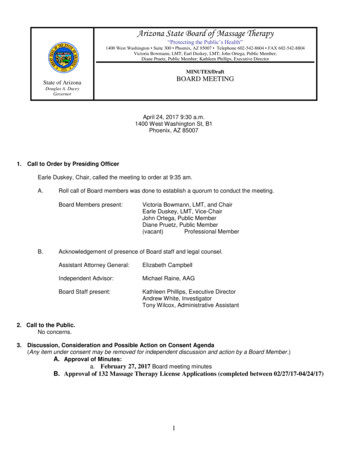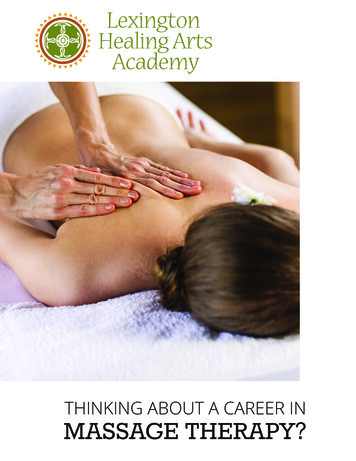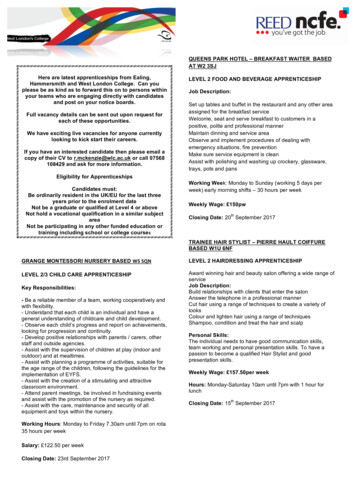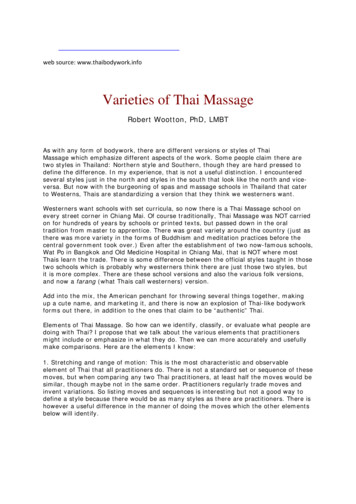
Transcription
web source: www.thaibodywork.infoVarieties of Thai MassageRobert Wootton, PhD, LMBTAs with any form of bodywork, there are different versions or styles of ThaiMassage which emphasize different aspects of the work. Some people claim there aretwo styles in Thailand: Northern style and Southern, though they are hard pressed todefine the difference. In my experience, that is not a useful distinction. I encounteredseveral styles just in the north and styles in the south that look like the north and viceversa. But now with the burgeoning of spas and massage schools in Thailand that caterto Westerns, Thais are standardizing a version that they think we westerners want.Westerners want schools with set curricula, so now there is a Thai Massage school onevery street corner in Chiang Mai. Of course traditionally, Thai Massage was NOT carriedon for hundreds of years by schools or printed texts, but passed down in the oraltradition from master to apprentice. There was great variety around the country (just asthere was more variety in the forms of Buddhism and meditation practices before thecentral government took over.) Even after the establishment of two now-famous schools,Wat Po in Bangkok and Old Medicine Hospital in Chiang Mai, that is NOT where mostThais learn the trade. There is some difference between the official styles taught in thosetwo schools which is probably why westerners think there are just those two styles, butit is more complex. There are these school versions and also the various folk versions,and now a farang (what Thais call westerners) version.Add into the mix, the American penchant for throwing several things together, makingup a cute name, and marketing it, and there is now an explosion of Thai-like bodyworkforms out there, in addition to the ones that claim to be “authentic” Thai.Elements of Thai Massage. So how can we identify, classify, or evaluate what people aredoing with Thai? I propose that we talk about the various elements that practitionersmight include or emphasize in what they do. Then we can more accurately and usefullymake comparisons. Here are the elements I know:1. Stretching and range of motion: This is the most characteristic and observableelement of Thai that all practitioners do. There is not a standard set or sequence of thesemoves, but when comparing any two Thai practitioners, at least half the moves would besimilar, though maybe not in the same order. Practitioners regularly trade moves andinvent variations. So listing moves and sequences is interesting but not a good way todefine a style because there would be as many styles as there are practitioners. There ishowever a useful difference in the manner of doing the moves which the other elementsbelow will identify.
As mentioned, the collection of moves used in Thai has always changed. One source isborrowing from other modalities. Thai culture has always been very adaptive. When theysee Westerns doing something they like, they incorporate it, putting their own spin on it.Even though Americans like to call Thai Massage “Thai YOGA Massage”, yoga asanapractice was NOT practiced in Thailand until recently when Thais saw Westerners doingit. Thai Buddhist monks do not do yoga. So the moves in Thai do not come directly fromyoga asanas as Americans now know it.But ironically, now the collection of Thai moves – and the way they are done – is beinginfluenced by a re-interpretation of the moves by Western yoga practitioners.Practitioners who were trained in yoga asanas before coming to Thai massage naturallyinterpret the Thai moves in light of their yoga training and make the moves look morelike yoga than they originally were. So a new style is emerging in America that turnsThai into “yoga massage” and even into a form of “assisted yoga”.2. Whole-body & four positions: This is another unique characteristic of Thai Massagethat we can expect of all practitioners if they are really doing Thai massage. They willnot just do one part of the body but treat the whole, usually from feet to head. Andusually in more than one position, preferably all four: supine, side-lying, prone, sitting.There is a difference in the order of positions worth noting. One style is to do eachposition in order, finishing with one position before going to another. Another style is tostart in one position, e.g. supine, and at some point change to another, e.g. side lying,and then return to the first position.There are interesting variations in preference for using one position or another to treat acertain part. For example, some like to treat arms in supine position while others treatthem in side lying. This is simply a difference in preference rather than style sincepractitioners probably know how to treat the arms in both positions but prefer one.3. Sen line treatment (energy lines or meridians): Probably only half of practitioners dothis, so it is a good distinguishing element for defining a style. There are differences asto where the sen run as well as a variety of ways of treating them. Some use a lighttouch and others are more forceful, but they would have in common the characteristicThai way of treating the whole line rather than just specific points. This distinguishesThai from Shiatsu. So specifically treating sen lines in some way can distinguish onestyle of Thai Massage from styles that do not treat sen lines.4. Jap sen: We can expect all practitioners to do ‘palming’, ‘thumbing’ and ‘compression’and to use feet as well as hands and occasionally elbows, knuckles, and knees. But onetechnique is only done by a minority: It is a cross-fiber technique called in Thai jap sen,literally, “pluck the line”. Some call it “nerve touch.’ When it is used extensively over thebody throughout the treatment, it is a defining characteristic of one style of ThaiMassage.
5. Meditation: Practitioners generally make a respectful gesture before giving atreatment called wai, and many will say that Thai traditionally incorporates metta“loving-kindness”, but very few actually do metta meditation throughout the treatmentand make the whole treatment into a meditation. How much emphasis is given to thespiritual aspect and how meditative the treatment is for both client and practitioner is aless observable element but can have a huge effect on the experience and on the healingeffect of the treatment.6. Subtle energy work: Treating the sen is a form of energy work which involvesphysically touching the body. But a few practitioners do more subtle energetic/spiritualwork aimed at affecting the over–all flow of energy/prana/chi around and through theperson or sending it to certain areas. It may involve projecting energy through theirhands or with their breath or some other mental/heart action. This is not as observableas the sen work, but one definitely feels something else is going on beside the physicalwork.7. Breath work: A few practitioners use specific breathing techniques along with eachmove to facilitate the delivery. This is barely observable, but it can make a big differencein the quality of the touch and effectiveness of the moves.8. Pace & rhythm: There is a big difference in pacing among practitioners. Some workquickly/vigorously doing multiple repetitions of moves and compressions up and downlimbs. Others move slowly, deliberately, stopping and holding moves. For many, thetreatment is a collection of individual moves chosen to treat the particular client’sconditions, the focus being on each move. Others deliberately use the rhythm andsequencing of the moves to create an effect as part of the effectiveness of thetreatment. So there is a style that is fast & energetic and a style that is slow &methodical and a style that is rhythmically flowing.9. Pressure. Thai Massage gives practitioners a lot of leverage as they use their wholebody, so they can easily apply a lot of pressure in their touch and movements. Probablythe majority of Thai people who do Thai Massage use that leverage to the maximum andwork with the notion of “no pain, no gain”. But a few masters use a light or gentle touchthat never-the-less has a deep effect. Often accompanying this gentle touch will be moreuse of energy work and rhythm to make the effect deeper. So there is a gentle style ofThai that differs noticeably from the common forceful style.10. Herb packs: Thai massage does not use oil as in Swedish massage, but it does usesteamed herbal packs to accompany the work. These can be applied before or during therest of the treatment.11. Effect: Most Thai treatments increase flexibility and as a consequence of this openingone often experiences more energy. Traditionally in Thailand, relaxation, as Americanshave come to expect it from massage, was not an intended effect. The treatment wasconsidered like medicine, and pain and bad taste were accepted as part of traditionalmedicine. But in the hands of some masters, Thai can give deep relaxation and evenimpart a psychological sense of well-being. So I think there is a style or manner of doingThai that actually aims at deep therapeutic relaxation and feeling of nurture and wellbeing in addition to the usual flexibility.
12. Western Physiology: Another influence that is changing Thai Massage today iswestern massage technique with it focus on anatomy and physiology. In Thailand andother Asian countries there was NO science of dissecting the body and naming themuscles. So the moves in Thai Massage were not originally thought of as affectingspecific named muscles in the way western massage therapists are trained to think. Butnow when western massage therapists learn Thai they naturally want to know whichmuscles each move treats and which moves will treat specific muscles, like thepiriformis. So now Thai moves are getting adjusted to target certain muscles as westernanatomy considers them. This does make Thai more precise from the standpoint ofphysical anatomy. But it also keeps the focus on the physical level and can make thetreatment mechanical. So a style of Thai massage is developing that is morephysiologically focused.13. Foot Thai: In America when peanut sauce is added to any dish it gets the label “Thai”in the menu (even though peanut sauce is rarely used in Thailand and there are so manymore distinctive elements in Thai cuisine). Similarly, use of the feet in doing bodyworkseems to make it “Thai” in popular thinking – and the more use of feet, the better, ormore “Thai”. Thai massage does use feet, but not more than hands are used, and it iscertainly not about doing everything with the feet. (Thai culture is sensitive to theshowing and use of feet, so there is a polite limit to how much feet would be used in Thaimassage.) There are other modalities of bodywork that use feet more than Thai, such as“Barefoot Shiatsu.” So there is some confusion as to the origin of so much foot work,whether it is from Thai or other modalities or just practitioners making up things to dowith their feet. But it seems that a new style of bodywork is developing that makes feetthe main thing, replacing hands, and this style may get labeled “Thai”.14. Table Thai: The massage table is a western invention. A traditional Thai house hasvery little furniture and almost everything is done on the floor. And they prefer it thatway. There is a simplicity and even elegance to sitting and doing things on the floor –which is of course kept clean, as shoes are left at the door. Giving and receiving Thaimassage on the floor has a certain feel, groundedness and connection that is missing ona table. However, it is possible to do a variation of at least half of the moves on amassage table, and western therapist can easily incorporate many Thai moves andelements into the other modalities they do on a table. That could be called “Swedish withThai flavoring”. It is also possible for Thai practitioners who do the regular floor Thai totransfer their work with some adaptations to the table. In this case the intention is to doThai, but adapted to a table. “Table Thai” will not have the same quality as Thai on amat, but it could be called a new version of Thai.After receiving a number of treatments from a variety of practitioners, one does havethe impression of qualitative differences. Some treatments are very physical with a lot ofmovement and forceful pressure while others are more gentle with perhaps fewermovements but the sense that more is going on at an energetic level. So there is arange from the very physical to the meditative or esoteric.
Using the above elements we can now identify what makes the difference betweenvarious styles, and we can see that many variations are possible. It would take a bigchart to show all the possibilities. The main ones are these:A. Physical or yoga style: elements 1, 2, 9 (forceful)B. Physical plus sen work: elements 1, 2, 3C. “Jap Sen”: 1, 2, (3), 4, 9 (forceful)D. Meditative energy work style: 1, 2, 3, 5, 6, 7, 8 (rhythmic flow), 9 (gentle), 11(relaxation)E. Herb packs can be used with any other style but is common with “Jap Sen” (C).F. A variation to any style can be made by changing the pace & rhythm (8), or thepressure (9), or adding Jap sen (4), meditation (5), breath work (6), or herb pack (10)Individual background & experience: In the end, no matter what style a Thai practitioneris originally taught, what one gets is an individual who comes to the work with aparticular background that effects the way they see, understand, and apply the Thaimodality. Furthermore, the experiences they have with their clients will also shape theway they practice Thai and can change their whole approach.We can learn a set of moves in school, but then it is our clients in actual practice whoteach us what we can and cannot do with those moves and sometimes stimulate us toadapt or invent moves. Our experience with our clients – what issues they bring to usand what we find works and doesn’t work with them – is our biggest teacher and shapesthe personal style we develop.For example, a young Thai Massage therapist who comes to Thai with a strongbackground in yoga asanas and whose clients are mainly young yogis and athletes willhave a very different approach to Thai Massage than an older therapist who has a strongbackground in Buddhist meditation and whose clients are middle aged and older withserious conditions. Speaking personally as the second person in that example, my stylehas changed over 20 years to become more gentle and simple with more emphasis onenergy work. I’m learning to be more efficient in my moves to achieve a deeper effectwith a lighter touch or when needed to use stronger pressure without hurting myself inthe process.There is a natural tendency, born of necessity for bodyworkers as we get older to “worksmarter rather than harder”. This is true for Thai people as well. I was impressed by theolder masters I knew in various fields, music, crafts, farming, construction, and sports,as well as bodywork to have an elegance, gracefulness, efficiency in the way they dideverything. To me, when that style is applied to Thai Massage it becomes a smoothflowing dance.So, there is NOT one original, authentic Thai Massage (Nuat Boran). And I’m not surehow appropriate it would be for Americans anyway. In Thailand there is no boundary linebetween Massage Therapist, Chiropractor, MD, and Pharmacist, and therapists there donot have to be as safety conscious as we do. On the other hand, in the ancient tradition,students apprenticed with master teachers for a lot longer than therapists go to school inthe west, and teachers were true masters with a lifetime of experience. Butunfortunately that system is rare now in Thailand and Westerners are now the drivingforce in the continuation, development and change of Thai Massage.
I hope this attempt to identify elements and styles of Thai Massage shows how rich withpossibilities the Thai modality is. I believe good Thai practitioners should be adaptableand be able to use effectively a number of different techniques so they can adjust to thevarious needs of different clients. We should be able to shift between firm and light,between vigorous and soothing, to give the stretches a young athlete needs and towisely select and sensitively apply moves appropriate to an older client with backproblems. There is enough variety within the Thai family of styles to fit most conditions iftherapists will learn them.This attempt at describing the varieties of Thai Massage is still a work in progress. Butlet this be a stimulus to your own observation and exploration of Thai Massage.
Thai way of treating the whole line rather than just specific points. This distinguishes Thai from Shiatsu. So specifically treating sen lines in some way can distinguish one style of Thai Massage from styles that do not treat sen lines. 4. Jap sen: We can expect all practitioners to do 'palming', 'thumbing' and 'compression'
